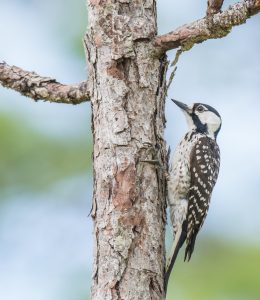
Conservation biologists from Michigan State University are looking back through time to determine the success of a 30-year intervention and monitoring project designed to rescue the red-cockaded woodpecker, a long-imperiled bird living within the boundaries of Florida’s Avon Park Air Force Range. And the Fitzpatrick Lab, based at the W.K. Kellogg Biological Station, recently produced a study that examines translocation—moving individuals from donor populations to isolated, at-risk ones—as an approach to help bring dwindling species back from the brink.
Their results, published in a special edition of Proceedings of the National Academy of Sciences, demonstrate the potential for translocations to reverse long-term population decline in endangered species.
These findings emphasize how effective the careful introduction of new individuals can be in short- and long-term conservation efforts, presenting a potential boon for threatened and endangered species. When used in concert with land protection and management strategies such as controlled burns, interventions at the individual level can help dwindling communities recover.
Rare birds in a ‘Sentinal Landscape’
Red-cockaded woodpeckers, once abundant from the American South to the Eastern seaboard, have disappeared, alongside their pine savannah habitat, and now are confined to small, disconnected pockets. Those fragmented areas cover just three percent of their historic range. “The only reason that these populations are still around is because of the continued collaborations and long-term investment in these imperiled species,” explained Alex Lewanski, a graduate student at MSU and first author on the study.

The Avon Park Air Force Range contains over 35,000 acres of pine savannah, providing a well-protected band of habitat for threatened animals and a proving ground for complex conservation strategies. It’s home to one of 18 Sentinel Landscapes.Recognizing the opportunities present in this protected area, researchers from Archbold Biological Station, in collaboration with the U.S. Fish and Wildlife Service and the U.S. Air Force, introduced fifty-four red cockaded woodpeckers from six donor populations into the range’s pine savannahs between 1998 and 2016. Analyses revealed that translocations provided substantial and extended benefits, improving the population’s size and overall genetic health.
MSU researchers determined that the introduced birds contributed directly to higher population counts, and that translocated birds and their descendants tended to have higher rates of survival and reproductive success.Translocated birds tended to nest for more years than locally hatched ones, and some 70 percent of the translocated woodpeckers survived in the population after their release, In addition, many formed breeding pairs with local individuals, providing a boost to the genetic diversity of the population.
Implications for future conservation efforts
The team hopes that these positive results incentivize land managers to consider the long-term benefits of translocations and continued monitoring.
In the future, Lewanski expects that genetic insights will play a growing role in tracking and evaluating conservation programs, more effectively gauging their effectiveness. Analysis of genetic material helps detect and minimize inbreeding and create highly detailed pedigrees for populations, reducing the burden of on-site monitoring programs to track bird nesting and reproduction.
Using genetic monitoring tools allows scientists and land managers to be more precise when deciding how and when to use translocations, according to Sarah Fitzpatrick, KBS resident faculty member, MSU associate professor, and senior author on the study. Eventually, a combination of genomic analysis and on-site monitoring could provide tailor-made strategies for managers attempting translocations.
~~~~~~~~~~~~~~~~~~~~
This study is the product of a partnership between Michigan State University, Archbold Biological Research Station, the U.S. Air Force, Department of Defense and the U.S. Fish and Wildlife Service.
Funding for managing and monitoring the Avon Park red-cockaded woodpeckers was provided by the Department of Defense, the U.S. Air Force, and the USFWS. Additional project support was provided by the National Defense Science & Engineering Graduate Fellowship from the Department of Defense and the National Science Foundation.
~~~~~~~~~~~~~~~~~~~~

A legacy of conservation; a commitment to sustainability.
3700 E. Gull Lake Drive
Hickory Corners, MI 49060
(269) 671-5117
info@kbs.msu.edu